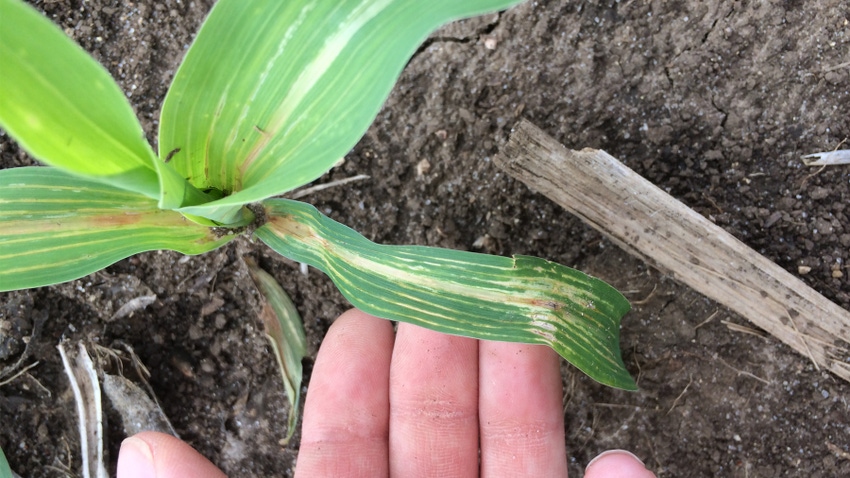January 18, 2024

For many Iowa producers, the 2023 growing season was fairly dry, which increases the potential of herbicide carryover in 2024. Several factors determine how long herbicides can persist.
In general, soils with a high clay and organic matter content have a greater chance at herbicide carryover. This is due to the higher number of binding sites for the herbicide to attach to on the soil particle. This “tie-up” results in decreased initial uptake by the plant and herbicidal activity. More herbicide is held in reserve, potentially injuring susceptible crops in the future.
Soil pH can influence the persistence of some herbicides. This is particularly true with the triazines such as atrazine and sulfonylureas such as chlorimuron or Classic. Both chemical breakdown and microbial breakdown are two ways herbicides degrade in soil. They often occur more slowly in higher-pH soils.
In particular, the chemical degradation rate of the triazine and sulfonylurea herbicide families slows as soil pH increases, particularly above 7. In higher-pH soils, lesser amounts of these herbicides bind to soil particles, making more available for plant uptake.
Thus, triazine and sulfonylurea herbicides persist longer in higher-pH soils and are more available for plant uptake. However, some triazine and sulfonylurea herbicides do not persist and carry over, regardless of how high the soil pH is. Most farmers have learned where and at what rate these products can be used safely.
However, low soil pH increases the persistence of the imidazoline herbicides, such as imazethapyr (Pursuit). As the soil pH drops below 6.0, imazethapyr increasingly binds to soil particles. Adsorption of these herbicides appears to reduce their availability to soil microorganisms, the primary mechanisms of degradation. Even though adsorption is greater in lower-pH soils, the herbicide can still be released several months later, becoming available for plant uptake and potentially injuring a following sensitive crop.
Another process that’s responsible for breaking down herbicides is degradation, which is done by the soil microorganisms. In order for them to achieve optimum growth for ideal herbicide breakdown, they need a warm, well-aerated, fertile soil with a pH as close to 7 as possible.
Climatic conditions
Climate also affects how a herbicide breaks down. Climatic factors include:
moisture
temperature
sunlight
As moisture and temperature increase, the more herbicide degradation occurs. Moisture degradation of the herbicide — known as hydrolysis — is a key process that breaks down herbicides. Thus, the year following a drought is usually problematic, with some herbicide carryover issues arising.
The half-life of a herbicide describes the length of time it takes for 50% of the herbicide to break down to secondary compounds. Herbicide chemistry and the application rate can impact the persistence of phytotoxic herbicide residues in the soil.
Most active ingredients used in Iowa are not persistent enough to pose a carryover risk. Products (commercial name examples included) that have half-lives sufficient to result in occasional carryover include:
atrazine (Aatrex)
chlorimuron (Classic)
clopyralid (Stinger)
fomesafen (Reflex)
imazethapyr (Pursuit)
isoxaflutole (Balance Flexx)
mesotrione (Callisto)
Minimizing carryover risks
Herbicides that have the potential to carry over into the next season tend to have re-cropping intervals of nine to 10 months or longer.
The potential for carryover injury to rotation crops is influenced not only by the amount of herbicide present in the soil, but also on the susceptibility of the rotational crop and early-season growing conditions. Because of these interacting factors, it is difficult to accurately predict the likelihood of injury occurring in a specific field.
A farmer can minimize risks of problems in fields suspected of having carryover potential by these steps:
Avoid very early planting dates.
Choose hybrids or varieties with good early-season vigor.
Select herbicides with high margins of crop safety.
Increased tillage has not consistently reduced problems associated with low levels of herbicide residues, particularly systemic products such as ALS inhibitors. These include imidazolines such as imazethapyr (Pursuit) and sulfonylureas such as chlorimuron (Classic).
Avoid using herbicides with the same mode of action as the herbicide suspected to pose a carryover risk. The amount of herbicide remaining in the soil from last yea’s application may be insufficient to pose a threat to a rotational crop. However, if a second herbicide with the same mode of action is applied to the field, the additive effect of last year’s residues and the current herbicide may overwhelm the crop’s defense system.
Check the labels for the herbicides you applied in 2023 for the rotation interval of the crop you plan to plant in 2024. To be safe, use a bioassay if there are more months that must typically pass between your 2023 herbicide application and when you plan to plant this year.
To run a bioassay, fill several disposable cups with soil from numerous areas of the field in question in spring, sow the crop seed in the soil, water the soil and wait. If the seed germinates, and the seedling emerges and looks fine, your crop is likely safe to plant in that field. If not, consider selecting a less sensitive crop.
Read more about:
HerbicideAbout the Author(s)
You May Also Like






